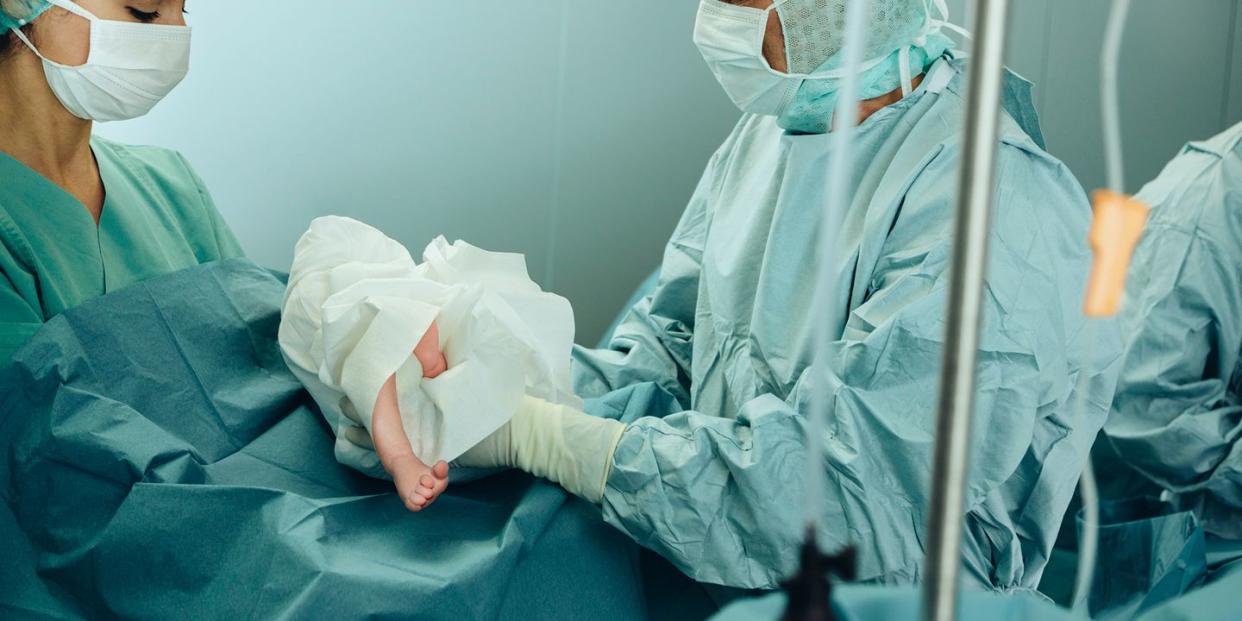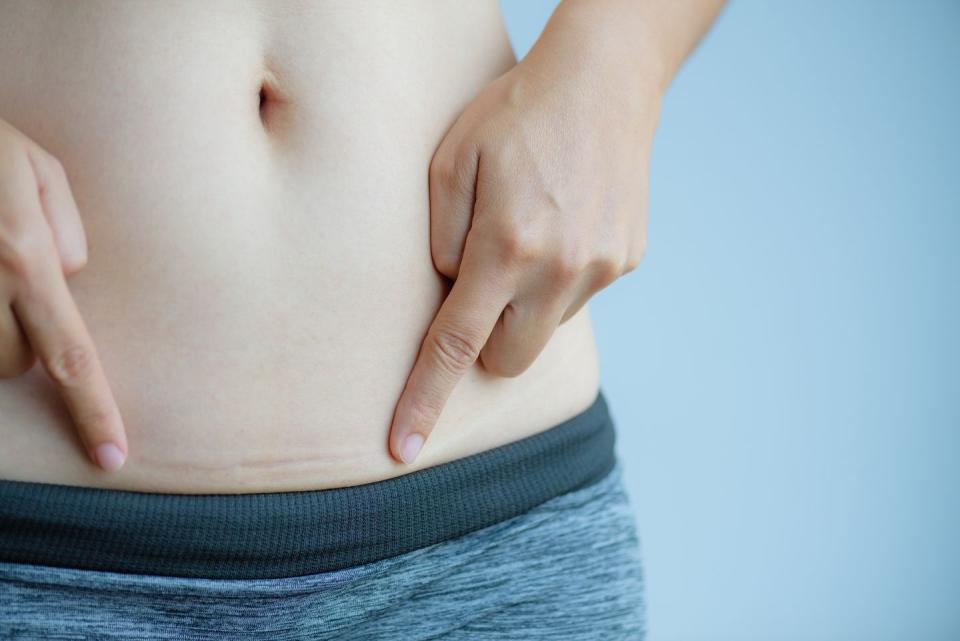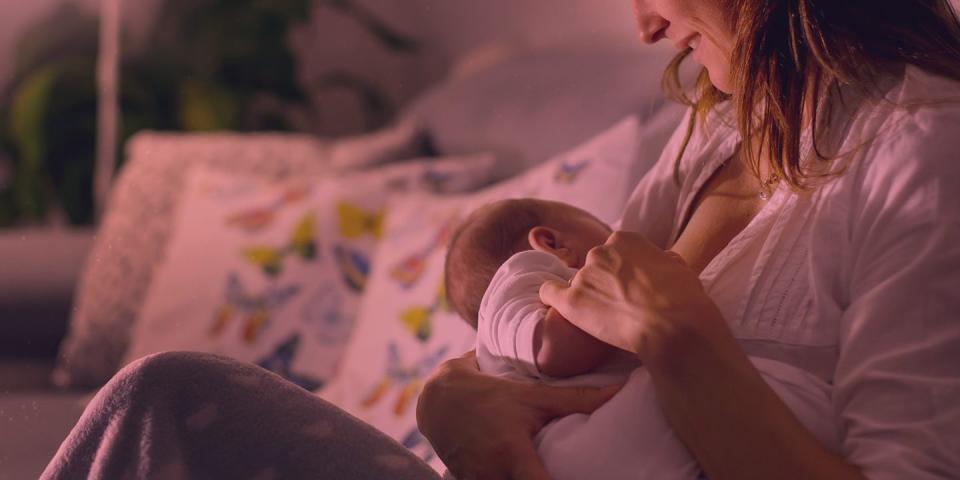6 myths about caesarean sections too many women believe

Until you've actually had a caesarean section - or been in the room when someone else has undergone one - you don't really know much about it. It's not like there's lessons in school or anything, which can leave people with burning questions, like: Will a c-section leave me with a big, visible scar?
You might be relieved to hear the answer to that question is no, not usually. But that's not the only myth that's often batted around when it comes to caesarean sections. So we asked Dr Penelope Law, Consultant Obstetrician and Gynaecologist at HCA Healthcare UK's The Portland Hospital (and, er, also the Countess of Bradford, casually) to bust 'em all for us.
"Hearing the many myths that surround the delivery of your baby can cause expectant mums unnecessary worry and anxiety at a time when feeling calm is key," Dr Penelope tells Cosmopolitan UK.
Myth 1: C-section scars are big and visible
"Many women who are due to have a C-section may be concerned about a scar on their abdomen," notes Dr Penelope, acknowledging that the concern is completely normal. But you needn't panic. "Women should know that most scars will fade significantly and form a thin white line by your baby’s first birthday," the expert reassures.
Plus, the location of the scar means it's often hidden, so would only be visible at your most intimate. "In most cases, this scar forms a horizontal line just above the pubic area, around 10-cm in length (the size of the baby’s head)," says Dr Penelope. "Ultimately, C-section scars are hidden under a bikini or underwear, and as mentioned, can fade significantly within the first year.
"If your scar is painful, raised or persistently red, you should speak to your obstetrician, GP, midwife, or health visitor about ways to minimise discomfort," she adds.

Myth 2: If you’ve already had a C-section, you won’t be able to have a vaginal birth for future pregnancies
This just isn't true. "Having a C-section shouldn’t prevent women from subsequently trying a vaginal birth, if they wish," says the gynaecologist. "Many women do choose to have a vaginal birth after a caesarean (sometimes referred to a as 'VBAC'). Unless medically advised not to, as a small number may be, women can opt to have a vaginal delivery."
Myth 3: There’s a limit to the number of C-sections you can have
Again, nope. You just have to be aware of the risks. "There is no set limit to how many C-sections a woman can have – but the risk of complications does increase with the number of caesarean sections undertaken," says Dr Penelope. "Medical risks do increase with each procedure. These risks include uterine scar rupture bladder and bowel injuries, bleeding, and complications with the implantation site of the placenta."
For this reason, the gynaecologist advises that "a plan for the optimal delivery mode should be made in each pregnancy and individualised for each woman. Women who are concerned about complications should speak to their obstetrician or midwife."
Myth 4: You can’t breastfeed babies delivered via C-section
"Whether a woman opts to breastfeed, or bottle feed is entirely up to her. If a she chooses to breastfeed, the method of delivery should have no major effect on their ability to do so," explains the doctor. If you undergo an emergency caesarean, however, Dr Penelope warns the breastmilk can take a little longer to come in. This is "usually because the mother is very tired", but the rates of breastfeeding tend to be the same regardless of the delivery method.
"For mums struggling to breastfeed, whether after a c-section or vaginal delivery, it is best to meet with a lactation consultant or a midwife who specialises in breast feeding who can offer help, advice and support, and make the whole process easier," she suggests.

Myth 5: The recovery period for C-section and vaginal delivery is more or less the same
While you shouldn't expect to recover instantly from either a vaginal delivery or caesarean section ("it's certainly not something that happens overnight," says the gynaecologist), there is generally a difference in recovery time between the two.
"It does tend to take longer for women to move and walk easily after a caesarean section when compared to an uncomplicated vaginal delivery," says Dr Penelope. "Women who have had a vaginal birth can leave the hospital after six hours (or may deliver at home) and have a recovery time of around one week. In contrast, women who have had a C-section may choose to go home after 24 hours but most stay for 2-3 days and may not feel fully recovered for 2 to 4 weeks. It is more likely for women who have had a caesarean to need more time before they can resume exercise, or lift heavy items."
Myth 6: You won’t feel anything at all, good or bad, during a C-section
"Although there won’t be any pain due to the anaesthetic provided during a C-section, some women may still feel some tugging or pressure, often described as a 'rummaging' feeling," explains the doctor. Well, there are human hands fiddling about inside your womb, after all.
"Nausea immediately after all deliveries is also common. C-sections incur different feelings and sensations than vaginal deliveries but the emotion at seeing your baby will be there whatever delivery method you experience," says Dr Penelope.
Follow Cat on Instagram.
('You Might Also Like',)

